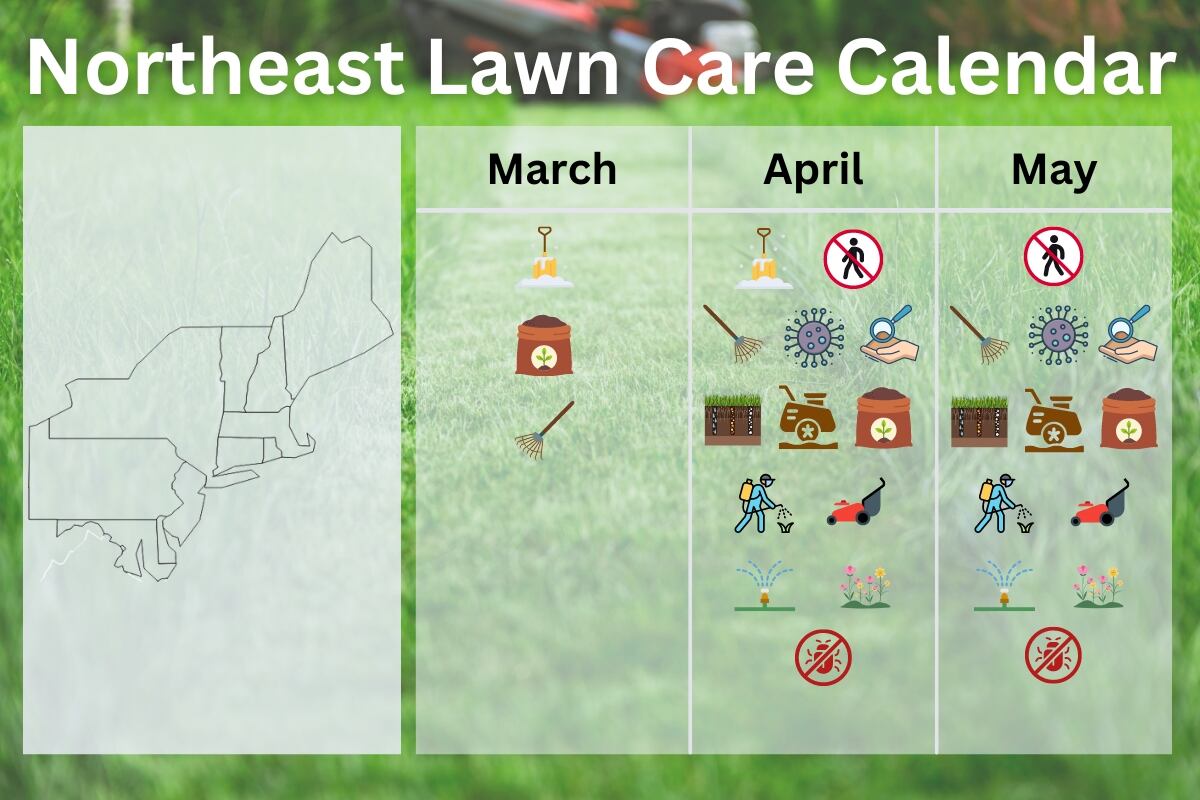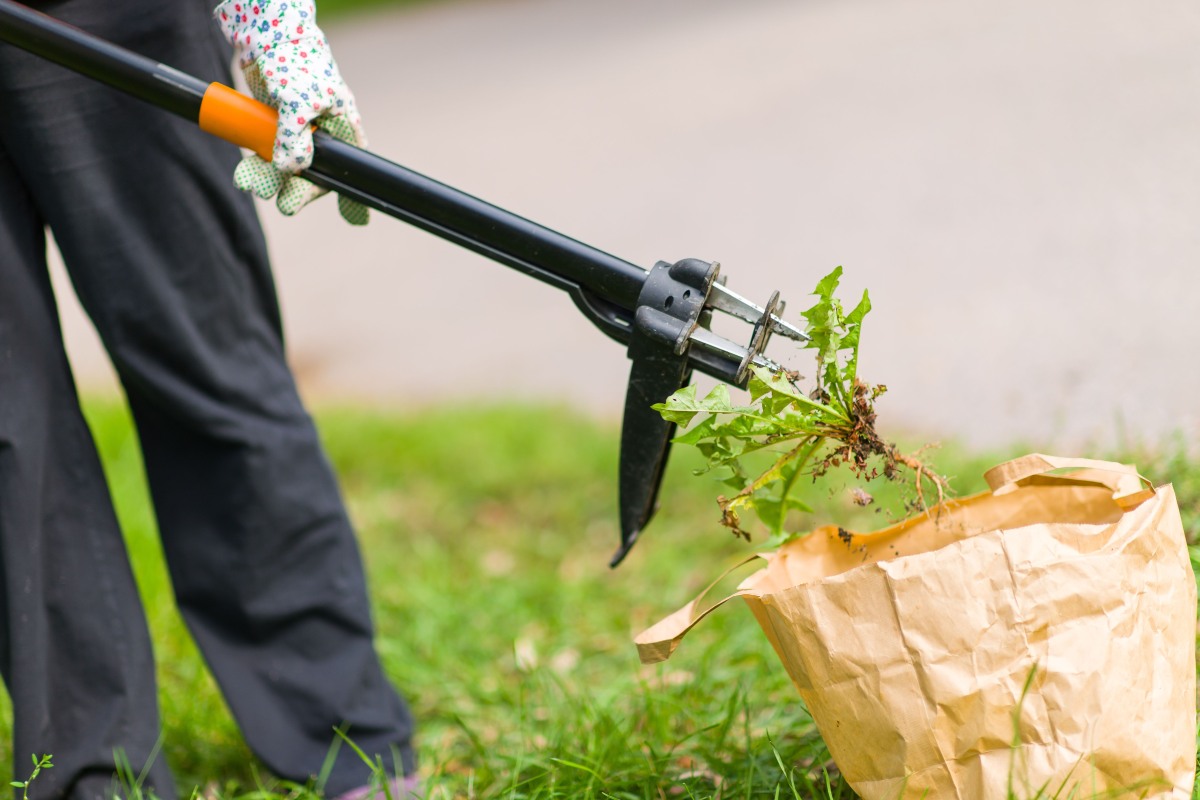
A weed and feed is a 2-in-1 product that can control weeds and nourish your lawn to green perfection, if applied at the right time.
The golden rule is to take advantage of the sweet spots of spring and fall, when temperatures hit that perfect 60 F to 90 F window. This is when grass is primed to absorb nutrients, and weeds are vulnerable to herbicides. Need more details? This article tells you when to apply weed and feed to your lawn, with expert insights.
Best Times for Weed and Feed

Here’s the quick answer to your question, but our guide contains some important details that you should not miss.
| Best Season | Spring and/or fall |
| Ideal Temperature | Daytime temperatures consistently between 60 F and 90 F |
| Plant Activity | Turfgrass is actively growing |
| Weather Conditions | Mild, windless day No rain in the 24- to 72-hour forecast (depending on product) |
| Best Time of Day | Early morning or early in the evening *If the product requires a wet application, the best time is early morning on a dewy lawn or after a light rain. |
| Newly Seeded Lawn | Wait until you mow at least 3 times (about 2 months). |
Don’t apply weed and feed more than twice a year, and leave 30 to 60 days between the 2 applications. The best mix is the first application in the spring and the second in the fall.
Note: Check the indications on the weed and feed label. If you are unsure how to proceed, contact a lawn treatment professional.
Why Weed and Feed Timing Can Be Tricky
Turf experts are not big fans of weed and feed products because they prevent optimal timing and dosage for the fertilizer and herbicide.
As Pawel Petelewicz, assistant professor in the Agronomy Department at the University of Florida, notes, the time gap is especially large for pre-emergent treatments.
“For example, in North Florida, the ideal timing for preemergence herbicide is March 1, but the first recommended fertilizer application isn’t until April 15,” says Petelewicz.
You can get around this problem by:
- Applying a regular pre-emergent (like a crabgrass preventer) in early spring.
- Using a weed and feed with a post-emergent herbicide to kill any remaining weeds later in the season.
Application Timing Based on Regions

Here are the approximate time intervals to apply a weed and feed with a post-emergent or a mix of post- and pre-emergent herbicides by turf zone.
| Cool-Season Grass Regions | Spring: Mid-April to early June |
| Fall: Late August to mid-October | |
| Transition Zone | Spring: Cool-season grasses – Early April to mid-May Warm-season grasses – Mid-April to early June |
| Fall: Cool-season grasses – Mid-September to early November Warm-season grasses – September (before dormancy) | |
| Warm-Season Grass Regions | Spring: March to early June |
| Fall: September through early October |
Timing varies with local climate. Ask the local Extension office specialists for the best month to apply weed and feed in your area.
Spring Application
Bad timing risk: Applying a nitrogen-rich fertilizer too early and forcing leaf growth at the expense of root system health.
Early Spring
Ideal temperatures: Air temperatures above 60 F for at least 4 consecutive days.
If you live in the southern half of the country, you can start planning the weed and feed in late March or early April. The warm climate allows the turfgrass to green up early.
- Look for a formula with post-emergent and pre-emergent action (e.g., Scotts Turf Builder Bonus S Southern Weed & Feed2) so it can kill existing weeds and also prevent new weeds from growing.
- The best weed and feed is a low-nitrogen or slow-release product that doesn’t force leaf growth.
- Apply only when the grass is actively growing (after the second mow of the season).
According to University of Georgia experts, warm-season grasses have the highest risk of herbicide damage when transitioning from winter dormancy to active growth, so avoid applying weed and feed before the lawn greens-up in spring.
Late Spring
Ideal temperatures: Daytime temperatures stay under 90 F (85 F for Bermuda).
Mid-April to early June is a good time to apply weed and feed on cool-season lawns in the northern half of the country.
- Avoid feeding Kentucky bluegrass, ryegrass, or fescues later than the first week of June to allow your cool-season lawn to enter summer dormancy.
- Potassium improves drought stress resistance. If a soil test indicates a deficiency, look for a weed and feed high in potassium, like The Andersons Premium Weed and Feed 24-0-16.
If you haven’t treated your warm-season lawn in March or early April, you can apply a weed and feed formula until early June. In the southern part of the country, warm-season grasses prepare for their peak growing season and welcome the added nutrients.
Fall Application

Bad timing risk: Applying nitrogen too late in the season can delay dormancy and expose the grass to early frost.
Early Fall
Ideal temperatures: Daily air temperature drops below 80 F.
From September to early October, lawns recover from the summer stress. This is:
- The best time to feed cool-season grasses
- The last window for fertilizing warm-season lawns with nitrogen.
Choose a weed and feed that combines post-emergent with pre-emergent herbicides. Early fall is a good time to prevent winter annuals (e.g., poa annua, henbit) and cool-season perennials (dandelions) from germinating.
Note: In order for the pre-emergent to work, you need to apply the product when soil temperatures drop below 70 F (air temperature is below 80 F).
Late Fall
Ideal temperatures: Only apply as long as the daytime temperatures exceed 60 F.
By mid-October to early November, warm-season lawns are dormant or entering dormancy and should not be treated with a weed and feed. However, you might still have a small window to treat cool-season lawns in the transition zone:
- Choose a fertilizer higher in potassium and lower in nitrogen (e.g., 15-5-10) to improve cold hardiness and avoid triggering a late green-up when the first frost is approaching.
- According to Ron Honig, extension educator at the Kansas State University Extension, it is a good time to treat perennial weeds like dandelion and field bindweed. As weeds store nutrients in their roots, they’ll also carry foliar herbicides deeper through their structure. Use a weed and feed with only a post-emergent.
Note: Late fall applications can pollute the waterways as plants absorb fewer nutrients. Consult a lawn treatment professional before applying.
See Related: Fertilizer Numbers: What They Mean and How to Use Them
Why You Shouldn’t Apply Weed And Feed In Summer

Summer is the worst time to apply weed and feed on your lawn because of the summer stresses (high heat and drought). During this time, weeds and turf slow their growth, so herbicides and fertilizers are less effective and may even be harmful. During summer:
- Weeds are less efficient in moving systemic herbicides inside their structure and are harder to kill.
- Turf is more sensitive to the salts in weed and feed and can suffer from fertilizer burn during drought times — many products are high in quick-release nitrogen.
According to experts at North Dakota State University, some herbicides, like 2,4-D and dicamba, can volatilize and damage desirable nearby plants, such as flowering plants and shrubby ornamentals.
Precautions and Alternatives to Consider
The weed and feed combo also makes it easy to load your lawn with unnecessary chemicals. Overuse can pollute our waterways and harm the turf, so:
- Try weed-prevention techniques (e.g., mow the grass taller, mulch the grass clippings, overseed bare patches, and water 2-3 times per week).
- Test an organic weed and feed like corn gluten meal or hand-pull isolated weeds.
- Spot-treat with a weed killer spray if you only have a few weed patches on your lawn.
FAQ
The benefits of applying a weed and feed on your lawn are:
• Thicker turf
• Healthier, more resilient grass
• Effective weed control
• Time-saving application (combines two lawn care tasks into one)
It’s too late for a spring application when midday temperatures rise above 90 F (85 F for Bermuda). In the fall, it’s too late to apply weed and feed when temperatures drop below 60 F; the date varies by location, but a good rule of thumb is to consider mid-October as the end of weed and feed season.
Yes, you can apply a weed and feed after a lot of rain, but you must wait until the lawn and soil dry out a bit. You want moist soil (not waterlogged) and damp leaves, so the weed killer granules can stick and dissolve without being washed out.
Best Time to Hire a Professional
Timing a weed and feed application can be tricky, and these products only work if applied at the right moment. It’s easier and more effective to leave the scheduling to a professional.
Find a skilled lawn treatment pro near you with LawnStarter and reap all the benefits of weed and feed with zero effort from your part.
Sources:
- “It’s Warm Outside! Is it Time to Put Weed Control on my Lawn?” By Jeremy Kichler. University of Georgia.
- “Fall is the Best Time to Control Dandelions and Perennial Weeds.” By Ron Honig, extension educator. Kansas State Research and Extension.
- “Fall Lawn Weed Control.” By Paul O. Johnson, SDSU extension weed science coordinator. South Dakota State University Extension.
- Pawel Petelewicz, PhD., assistant professor in the Agronomy Department at the University of Florida, Gainesville, FL. Personal interview.
- “Temperature and Herbicide Application Questions.” North Dakota State University.
- “The Dilemma With Weed-and-Feed Lawn Products.” By Christopher Enroth, horticulture educator. University of Illinois.
- “Weed Control in Home Lawns.” By Patrick E McCullough, professor of Crop & Soil Sciences and Clint Waltz, extension specialist. University of Georgia.
Main Image Credit: Andrey Popov / Adobe Stock
LawnStarter participates in the Amazon Services LLC Associates Program, an affiliate advertising program. LawnStarter may earn revenue from products promoted in this article.




